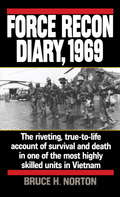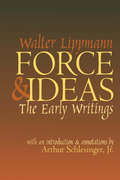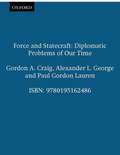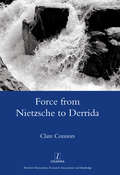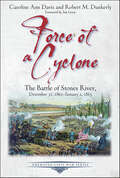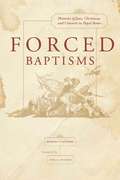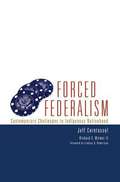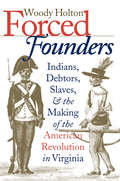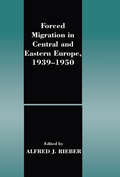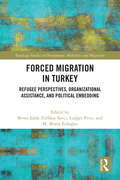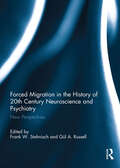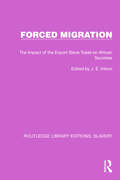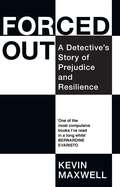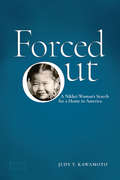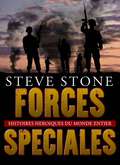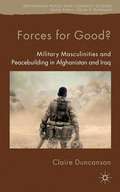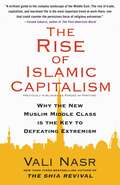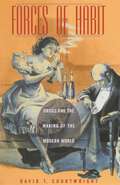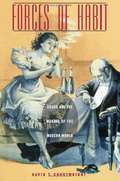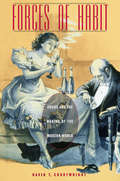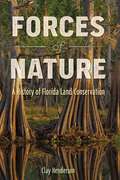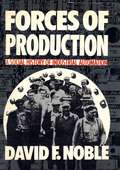- Table View
- List View
Force Recon Diary, 1969
by Major Bruce H. NortonThe riveting, true-to-life account of survival, heroism and death in the elite Marine 3d Force Recon unit, one of one two Marine units to receive the Valorous Unit Citation during the Vietnam War. Doc Norton, leader of 3d Force Recon, recounts his team's experiences behind enemy lines during the tense patrols, sudden ambushes and acts of supreme sacrifice that occurred as they gathered valuable information about NVA operations right from the source.
Force and Freedom: Black Abolitionists and the Politics of Violence (America in the Nineteenth Century)
by Kellie Carter JacksonFrom its origins in the 1750s, the white-led American abolitionist movement adhered to principles of "moral suasion" and nonviolent resistance as both religious tenet and political strategy. But by the 1850s, the population of enslaved Americans had increased exponentially, and such legislative efforts as the Fugitive Slave Act and the Supreme Court's 1857 ruling in the Dred Scott case effectively voided any rights black Americans held as enslaved or free people. As conditions deteriorated for African Americans, black abolitionist leaders embraced violence as the only means of shocking Northerners out of their apathy and instigating an antislavery war.In Force and Freedom, Kellie Carter Jackson provides the first historical analysis exclusively focused on the tactical use of violence among antebellum black activists. Through rousing public speeches, the bourgeoning black press, and the formation of militia groups, black abolitionist leaders mobilized their communities, compelled national action, and drew international attention. Drawing on the precedent and pathos of the American and Haitian Revolutions, African American abolitionists used violence as a political language and a means of provoking social change. Through tactical violence, argues Carter Jackson, black abolitionist leaders accomplished what white nonviolent abolitionists could not: creating the conditions that necessitated the Civil War. Force and Freedom takes readers beyond the honorable politics of moral suasion and the romanticism of the Underground Railroad and into an exploration of the agonizing decisions, strategies, and actions of the black abolitionists who, though lacking an official political voice, were nevertheless responsible for instigating monumental social and political change.
Force and Ideas: The Early Writings
by Walter LippmannThe acclaim for Lippmann the political thinker has at times obscured the equally impressive accomplishments of Lippmann the journalist. His output was prodigious, his influence on journalism significant. According to James Reston: "He has given a generation of newspapermen a wider vision of their duty." Early Writings provides a unique opportunity to rediscover this journalistic Lippmann and to observe the formative years of a brilliant mind.In 1913, just three years out of Harvard, Lippmann was asked by Herbert Croly to help plan and edit a new "weekly of ideas," the New Republic. Beginning with its first issue in 1914 and continuing through the following six years, Lippmann wrote numerous signed and unsigned articles. Here are the best of them, written during the exciting political era that began with the trauma of World War I and ended in the stasis of Republican Normalcy.Pulitzer Prize-winning historian, Arthur Schlesinger, Jr., places Lippmann in historical context while recreating the intellectual ambiance of the Wilsonian era. His annotations identify little-remembered personages and clarify issues that time has befogged. But in another sense, the issues and personages of 1910-1920 are only too familiar. Our world is still a world of war, ineffectual international political organizations, disappointed idealism, nerve-wracking platitudes, social unrest, and slinking politicians.
Force and Statecraft: Diplomatic Challenges of Our Time (Fourth Edition)
by Paul Gordon Lauren Gordon A. Craig Alexander L. GeorgePart One focuses upon the historical context of force and statecraft. Following a completely new Introduction, it ranges from a substantially restructured discussion of the early techniques, instruments, and ideas of diplomacy to the profoundly dangerous changes brought about by contemporary weapons of mass destruction and terrorism. Chapters cover the emergence of the Great Powers, the classical system of diplomacy, the diplomatic revolution, the creation of the United Nations, the rise and fall of the Cold War, globalization and the consequences of the Internet, and events as recent as 9/11, the Bush Doctrine, the "war on terrorism" and the American-led war in Iraq, nuclear proliferation in Iran and North Korea, and the World Summit of global leaders. Significant new material is added to this edition on the critical subject of human rights and its relationship to international peace and security. Part Two begins with the completely new and pivotal chapter on the subject of "Lessons of History and Knowledge for Statecraft." Each subsequent chapter then proceeds to systematically examine an especially important and challenging subject in diplomacy by means of delineating its theoretical principles and then analyzing three very specific historical cases in equal detail. The first of these always is drawn from the classical system of the nineteenth century, and the other two follow in a progression toward increasingly more recent events in contemporary international affairs. Particular care has been taken in this edition to include a number of new cases that reveal the truly global dimensions of these diplomatic challenges and thus range from Europe and the United States to the Middle East and Asia. Part Three opens with an entirely new chapter entitled "Ethics and Other Restraints on Force and Statecraft." This explores practical, structural, and political restraints upon policy makers; the debate over the nature of ethics and international politics; ethical restraints in foreign policy; and the difficult matter of observing ethical restraints, such as those of just war tradition, in warfare itself. A completely rewritten and updated Conclusion brings the major themes of the book together and offers a number of reflections about history, theory, the diplomatic revolution, and challenges ahead.
Force from Nietzsche to Derrida
by Clare Connors"What is the pervasive character of the world? The answer is force. But, as Heidegger asks next: ""What is force?"" Connors sets out to answer this question, tracing a genealogy of the idea of force through the writings of Nietzsche, Heidegger, Foucault and Derrida. These thinkers try to pin down what force is, but know too that it is something which cannot be neutrally described. Their vigorously literary writings must therefore be read as much for the stylistic and rhetorical ways in which they render force's powerful elusiveness as for the content of their arguments. And it is perhaps literature, rather than philosophy, which best engages with force. Certainly, for Connors, these philosophical positions are foreshadowed in remarkable detail by Shakespeare's Henry V - a play shot through with forces, imaginary, military, rhetorical and bodily."
Force of a Cyclone: The Battle of Stones River, December 31, 1862–January 2, 1863 (Emerging Civil War Series)
by Robert M. Dunkerly Caroline Ann DavisAuthors Caroline Davis and Bert Dunkerly explore a significant turning point of the Civil War—a battle that had the highest percentage of casualties on both sides. All of Middle Tennessee held its breath when the new year dawned in 1863. One day earlier on December 31, Braxton Bragg’s Confederate Army of Tennessee faced off against William Rosecrans’s Federal Army of the Cumberland just outside Murfreesboro along Stones River. The commanders, who led armies nearly equal in size, had prepared identical attack plans, but Bragg struck first. His morning attack bent the Federal line back upon itself. The desperate fighting seesawed throughout the day amid rocky outcroppings and cedar groves. The Federals managed to avoid a crushing defeat and hold on until dark as the last hours of the old year slipped away. The cold and exhausted soldiers rang in the New Year surrounded by the pitiful cries of the wounded punctuated by cracks of skirmish fire while the opposing generals contemplated their next moves. With the fate of Middle Tennessee yet to be determined, President Abraham Lincoln’s Emancipation Proclamation went into effect on January 1, 1863. The president had signed the proclamation back in September of 1862, but he needed battlefield victories to bolster its authority. The stakes being gambled outside Murfreesboro were enormous. Determined to win the battle outright, Bragg launched another large-scale assault on January 2. The fate of the Army of the Cumberland and the impact of the Emancipation Proclamation hung in the balance. In Force of a Cyclone: The Battle of Stones River, December 31, 1862–January 2, 1863, authors Caroline Davis and Bert Dunkerly explore a significant turning point of the Civil War, and one that had the highest percentage of casualties on both sides of any Civil War battle. Lincoln himself would often look back on that fragile New Year’s Day and ponder all that was at stake. “I can never forget whilst I remember anything,” he told Federal commander Maj. Gen. William S. Rosecrans, “that about the end of last year and the beginning of this, you gave us a hard-earned victory, which, had there been a defeat instead the nation could scarcely have lived over.”
Forced Baptism
by Lydia Cochrane Marina CaffieroThis book makes use of newly available archival sources to reexamine the Roman Catholic Church's policy, from the sixteenth to nineteenth centuries, of coercing the Jews of Rome into converting to Christianity. Marina Caffiero, one of the first historians permitted access to important archives, sets individual stories of denunciation, betrayal, pleading, and conflict into historical context to highlight the Church's actions and the Jewish response. Caffiero documents the regularity with which Jews were abducted from the Roman ghetto and pressured to accept baptism. She analyzes why some Jewish men, interested in gaining a business advantage, were more inclined to accept conversion than the women. The book exposes the complexity of relations between the papacy and the Jews, revealing the Church not as a monolithic entity, but as a network of competing institutions, and affirming the Roman Jews as active agents of resistance.
Forced Federalism: Contemporary Challenges to Indigenous Nationhood (American Indian Law and Policy Series Volume #3)
by Jeff Corntassel Richard C. WitmerOver the past twenty years, American Indian policy has shifted from self-determination to “forced federalism,” as indigenous nations in the United States have encountered new threats from state and local governments over such issues as taxation, gaming, and homeland security. During the forced federalism era (1988–present), public perceptions of indigenous peoples as “rich Indians” have been just as damaging to Native nations as anti-sovereignty legislation. This book examines how state governments have manipulated “rich Indian” images when setting policies targeting indigenous peoples and discusses how indigenous nations have responded politically to these contemporary threats to their nationhood. Drawing on original survey data collected from Native governments from 1994 to 2000 and on interviews with Chief Chad Smith of the Cherokee Nation as well as other indigenous leaders, Jeff Corntassel and Richard C. Witmer II examine the power dynamics of the indigenous-state compacting system, and show how electoral activism among indigenous peoples has increased their political power while also giving rise to “rich Indian racism” among non-Indians—especially in the wake of the Indian Gaming and Regulatory Act. The authors warn that current widespread Native participation in non-Native politics is undermining both the political and the cultural foundations of indigenous nationhood, especially as the American culture of money gains influence in Native politics. They also offer specific strategies for regenerating indigenous communities in order to meet future challenges to their nationhood.
Forced Founders: Indians, Debtors, Slaves, and the Making of the American Revolution in Virginia
by Woody HoltonIn this provocative reinterpretation of one of the best-known events in American history, Woody Holton shows that when Thomas Jefferson, George Washington, and other elite Virginians joined their peers from other colonies in declaring independence from Britain, they acted partly in response to grassroots rebellions against their own rule. <p><p>The Virginia gentry's efforts to shape London's imperial policy were thwarted by British merchants and by a coalition of Indian nations. In 1774, elite Virginians suspended trade with Britain in order to pressure Parliament and, at the same time, to save restive Virginia debtors from a terrible recession. The boycott and the growing imperial conflict led to rebellions by enslaved Virginians, Indians, and tobacco farmers. By the spring of 1776 the gentry believed the only way to regain control of the common people was to take Virginia out of the British Empire.Forced Founders uses the new social history to shed light on a classic political question: why did the owners of vast plantations, viewed by many of their contemporaries as aristocrats, start a revolution? <p><p>As Holton's fast-paced narrative unfolds, the old story of patriot versus loyalist becomes decidedly more complex.
Forced Migration in Central and Eastern Europe, 1939-1950
by Alfred J. RieberThese nine case studies, written by Russian, German and Austrian scholars and based on archival findings, should shed new light on deportations and resettlement in Poland, Hungary, Czechoslovakia and Germany. The introduction places forced migration throughout the region in a historical context.
Forced Migration in Turkey: Refugee Perspectives, Organizational Assistance, and Political Embedding (Routledge Studies in Development, Mobilities and Migration)
by Ludger Pries Şafak Zülfikar Savcı, Berna M. Murat ErdoğanTurkey hosts more refugees than any other country in the world, with forced migrants from Syria, Afghanistan, Pakistan, Iraq, and other countries converging, either with hopes to settle in Turkey or to continue onwards to the European Union (EU).This volume addresses the specific experiences and trajectories of forced migrants in Turkey in the context of local and national contexts and the future of EU-Turkey relations. It presents the demographics of forced migrants, the biographies and future plans of refugees, and their interactions with civil society, states, and international agencies. A focus is on organized violence and corresponding experiences in countries of origin, during transit, and at current places.Based on extensive quantitative and qualitative research, this book will be of interest to researchers and practitioners in the fields of migration, human security, and refugee studies, as well as of sociology, political sciences, and international relations.
Forced Migration in the History of 20th Century Neuroscience and Psychiatry: New Perspectives
by Frank W. Stahnisch and Guel A. RussellThe forced migration of neuroscientists, both during and after the Second World War, is of growing interest to international scholars. Of particular interest is how the long-term migration of scientists and physicians has affected both the academic migrants and their receiving environments. As well as the clash between two different traditions and systems, this migration forced scientists and physicians to confront foreign institutional, political, and cultural frameworks when trying to establish their own ways of knowledge generation, systems of logic, and cultural mentalities. The twentieth century has been called the century of war and forced-migration, since it witnessed two devastating world wars, prompting a massive exodus that included many neuroscientists and psychiatrists. Fascism in Italy and Spain beginning in the 1920s, Nazism in Germany and Austria between the 1930s and 1940s, and the impact of the Soviet occupation of Eastern Europe all forced more than two thousand researchers with prior education in neurology, psychiatry, and the basic brain research disciplines to leave their scientific and academic home institutions. This edited volume, comprising of thirteen chapters written by international specialists, reflects on the complex dimensions of intellectual migration in the neurosciences and illustrates them by using relevant case studies, biographies, and surveys. This book was originally published as a special issue of the Journal of the History of the Neurosciences.
Forced Migration in the Spanish Pacific World
by Mehl Eva MariaNearly 4,000 Mexican troops and convicts landed in Manila Bay in the Philippines from 1765 to 1811. The majority were veterans and recruits; the rest were victims of vagrancy campaigns. Eva Maria Mehl follows these forced exiles from recruiting centers, jails and streets in central Mexico to Spanish outposts in the Philippines, and traces relationships of power between the imperial authorities in Madrid and the colonial governments and populations of New Spain and the Philippines in the late Bourbon era. Ultimately, forced migration from Mexico City to Manila illustrates that the histories of the Spanish Philippines and colonial Mexico have embraced and shaped each other, that there existed a connectivity between imperial processes in the Pacific and the Atlantic Oceans, and that a perspective of the Spanish empire centered on the Atlantic cannot adequately reflect the historical importance of the richly textured transpacific world.
Forced Migration: The Impact of the Export Slave Trade on African Societies (Routledge Library Editions: Slavery #6)
by Inikori J. E.Forced Migration, first published in 1982, examines the impact of the slave trade on Africa. There has been much debate over recent years about the effect of the Atlantic slave trade on Africa, with some authorities claiming that there were huge figures involved, and that these set back Africa's development for many years. Other historians reach lower estimates of the figures involved in the Atlantic trade, and hence argue that the effects on the political economy of Africa were more limited. Had widespread slavery existed long before the growth of the European slave trade? How important was the trans-Saharan traffic? Dr Inikori is the most authoritative voice in Africa to take part in this controversial international debate. He has done much original research into records, and here has made and introduced a selection of key papers. He has added elucidating editorial comments that place each paper in its context and link it to the other contributions.
Forced Out: A Detective's Story of Prejudice and Resilience
by Kevin MaxwellA gay, black, British police officer&’s memoir of prejudice, racism and homophobia on the force in the twenty-first century.Kevin Maxwell was a dream candidate for the police force—he had a long-held desire to serve his community, a strong moral compass and a clear aptitude for both the strategic and practical aspects of policing. And, as a gay black man from a working-class family, he could easily have been a poster boy for the force&’s stated commitment to equal opportunities. Joining just after the 9/11 attacks, Kevin entered policing determined to keep communities safe in the face of a changing world. But instead, he came up against entrenched prejudice, open racism and homophobia. For more than ten years, Kevin strove against the odds, until he took the force to an employment tribunal—with devastating results.Forced Out is a revelatory exposé combining deeply affecting memoir with sharp analysis and a fascinating insider perspective on day-to-day life in the force. It is a touchstone for the silent many who have either tried to ignore abuse for the sake of their career or who have been bullied out of their jobs. It paints a sobering portrait of an institution that has not yet learned the lessons of the past and whose prejudice is informing the cases it chooses to investigate and the way it investigates them. And it asks the important question: what needs to change?&“One of the most compulsive books I&’ve read in a long while.&” –Bernadine Evaristo, award-winning author of Girl, Woman, Other
Forced Out: A Nikkei Woman’s Search for a Home in America (Nikkei in the Americas)
by Judy Y. KawamotoForced Out: A Nikkei Woman’s Search for a Home in America offers insight into “voluntary evacuation,” a little-known Japanese American experience during World War II, and the lasting effects of cultural trauma. Of the roughly 120,000 people forced from their homes by Executive Order 9066, around 5,000 were able to escape incarceration beforehand by fleeing inland. In a series of beautifully written essays, Judy Kawamoto recounts her family’s flight from their home in Washington to Wyoming, their later moves to Montana and Colorado, and the influence of those experiences on the rest of her life. Hers is a story shared by the many families who lost everything and had to start over in often suspicious and hostile environments. Kawamoto vividly illustrates the details of her family’s daily life, the discrimination and financial hardship they experienced, and the isolation that came from experiencing the horrors of the 1940s very differently than many other Japanese Americans. Chapters address her personal and often unconscious reactions to her parents’ trauma, as well as her own subsequent travels around much of the world, exploring, learning, enjoying, but also unconsciously acting out a continual search for a home. Showing how the impacts of traumatic events are collective and generational, Kawamoto draws interconnections between her family’s displacement and later aspects of her life and juxtaposes the impact of her early experiences and questions of identity, culture, and assimilation. Forced Out will be of great interest to the general reader as well as students and scholars of ethnic studies, Asian American studies, history, education, and mental health.
Forced to Change: Crisis and Reform in the Canadian Armed Forces
by Colonel Bernd Horn Dr Bill Bentley Lieutenant-General Ret DallaireUndeniably, the 1990s were a period of crisis for the Canadian Armed Forces (CAF). Drastic budget reductions and a series of endless scandals all collided to form the perfect storm. The outcome of this was nothing short of the implosion of the Canadian Armed Forces Officer Corps. Stripped by the government of the right to regulate itself, the Officer Corps, which represented the nation’s stewards of the profession of arms, was forced to reform itself. Key to this transformation was education. However, the road was not easy, as cultural change rarely is. Forced to Change tells the story of how the Canadian Armed Forces found itself at its lowest point in history and how it managed to reform itself. The question is whether it was a fundamental transformation or just a temporary adjustment to weather the storm.
Forces Speciales : Histories Heroiques Du Monde Entier
by Steve StoneLes forces spéciales sont des unités militaires formées pour accomplir des missions non conventionnelles. Elles sont apparues au début du XXe siècle et ont connu un essor important au cours de la Seconde Guerre mondiale, avec la création de forces spéciales telles que les SAS et les U.S. Navy SEALs. Cette sélection d'histoires captivantes sur les forces spéciales du monde entier. Couvrant quatre décennies d'opérations extraordinaires, cette sélection de récits captivants des forces spéciales du monde entier. On y trouve notamment les opérations Eagle Claw, Gothic Serpent et Neptune Spear, ainsi que de nombreuses autres histoires pleines d'action. Les forces spéciales sont très respectées et les soldats qui font partie de ces unités d'élite ont subi une sélection et un entraînement difficiles pour arriver en première ligne. Qu'il s'agisse d'un opérateur de la Delta Force, d'un Navy SEAL, d'un soldat du SAS ou de tout autre opérateur des forces spéciales. Aujourd'hui, une étroite collaboration est la clé de nombreuses missions, même si la rivalité existe pour être le meilleur, le premier à atteindre un objectif ou à s'attaquer à une cible de premier plan. Les histoires de ce livre ont été choisies pour montrer non seulement les succès, mais aussi les échecs et les leçons tirées de chaque opération. La haute technologie ne remplace toujours pas les bottes sur le terrain, où des agents hautement qualifiés peuvent encore recueillir des renseignements qu'aucun œil dans le ciel n'est capable d'obtenir.
Forces for Good?
by Claire DuncansonThis book utilises the growing phenomenon of British soldier narratives from Iraq and Afghanistan to explore how British soldiers make sense of their role on these complex, multi-dimensional operations. It aims to intervene in the debates within critical feminist scholarship over whether soldiers can ever be agents of peace.
Forces of Fortune: The Rise of the New Muslim Middle Class and What It Will Mean for Our World
by Vali NasrFrom a "New York Times"-bestselling author comes a paradigm-changing revelation of the misunderstood rising force in the Islamic world--a non-extremist new middle class--that holds the key to winning the new Cold War against Iran and extremists.
Forces of Habit: Drugs And The Making Of The Modern World
by David T. CourtwrightWhat drives the drug trade, and how has it come to be what it is today? A global history of the acquisition of progressively more potent means of altering ordinary waking consciousness, this book is the first to provide the big picture of the discovery, interchange, and exploitation of the planet's psychoactive resources, from tea and kola to opiates and amphetamines.
Forces of Habit: Drugs and the Making of the Modern World
by David T. CourtwrightWhat drives the drug trade, and how has it come to be what it is today? A global history of the acquisition of progressively more potent means of altering ordinary waking consciousness, this book is the first to provide the big picture of the discovery, interchange, and exploitation of the planet's psychoactive resources, from tea and kola to opiates and amphetamines.
Forces of Habit: Drugs and the Making of the Modern World
by David T. CourtwrightWhat drives the drug trade, and how has it come to be what it is today? A global history of the acquisition of progressively more potent means of altering ordinary waking consciousness, this book is the first to provide the big picture of the discovery, interchange, and exploitation of the planet’s psychoactive resources, from tea and kola to opiates and amphetamines.
Forces of Nature: A History of Florida Land Conservation
by Clay HendersonThe activists and victories that made Florida a leader in land preservation Despite Florida’s important place at the beginning of the American conservation movement and its notable successes in the fight against environmental damage, the full story of land conservation in the state has not yet been told. In this comprehensive history, Clay Henderson celebrates the individuals and organizations who made the Sunshine State a leader in state-funded conservation and land preservation. Starting with early naturalists like William Bartram and John Muir who inspired the movement to create national parks and protect the country’s wilderness, Forces of Nature describes the efforts of familiar heroes like Marjory Stoneman Douglas and May Mann Jennings and introduces lesser-known champions like Frank Chapman, who helped convince Theodore Roosevelt to establish Pelican Island as the first national wildlife refuge in the United States. Henderson details how many of Florida’s activists, artists, philanthropists, and politicians have worked to designate threatened land for use as parks, preserves, and other conservation areas.Drawing on historical sources, interviews, and his own long career in environmental law, Henderson recounts the many small victories over time that helped Florida create several units of the national park system, nearly thirty national wildlife refuges, and one of the best state park systems in the country. Forces of Nature will motivate readers to join in defending Florida’s natural wonders.
Forces of Production
by David F NobleFocusing on the design and implementation of computer-based automatic machine tools, David F. Noble challenges the idea that technology has a life of its own. Technology has been both a convenient scapegoat and a universal solution, serving to disarm critics, divert attention, depoliticize debate, and dismiss discussion of the fundamental antagonisms and inequalities that continue to beset America. This provocative study of the postwar automation of the American metal-working industry-the heart of a modern industrial economy-explains how dominant institutions like the great corporations, the universities, and the military, along with the ideology of modern engineering shape, the development of technology. Noble shows how the system of "numerical control," perfected at the Massachusetts Institute of Technology (MIT) and put into general industrial use, was chosen over competing systems for reasons other than the technical and economic superiority typically advanced by its promoters. Numerical control took shape at an MIT laboratory rather than in a manufacturing setting, and a market for the new technology was created, not by cost-minded producers, but instead by the U. S. Air Force. Competing methods, equally promising, were rejected because they left control of production in the hands of skilled workers, rather than in those of management or programmers. Noble demonstrates that engineering design is influenced by political, economic, managerial, and sociological considerations, while the deployment of equipment-illustrated by a detailed case history of a large General Electric plant in Massachusetts-can become entangled with such matters as labor classification, shop organization, managerial responsibility, and patterns of authority. In its examination of technology as a human, social process, Forces of Production is a path-breaking contribution to the understanding of this phenomenon in American society.
